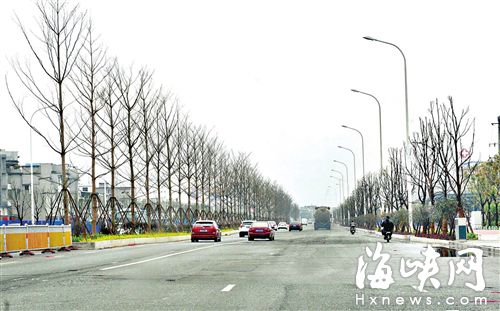Fuzhou Fuxia road greening project was terminated due to subway construction in 2010 and will be completed today “. Nearly 1.4 kilometers of road section, set up a central green sub-car belt and two green side sub-belt, three sub-car belt length of about 4 kilometers. More than 200 Terminalia mantaly trees and more than 400 camphor tree trees were planted on the sub-car belt. According to the construction contract, there are clear requirements for the specifications of these Avenue trees, which should not only improve the grade of urban roads, it will not affect road traffic. According to the Fuzhou municipal bureau of parks, more than 2,000 camphor tree trees have been planted in the shunting belt and green belt of Fuxia Road, which is second only to the Third Ring Road.

Fuxia Road has planted trees neatly and will become a landscape in a few months.
Road greening restoration camphor tree play the leading role
In 2010, Fuxia Road, which is undergoing Greening, was suspended due to the construction of Metro Line 1. The greening restoration construction of Fuxia road covers a total area of 120 mu, about 80,000 square meters, and construction has started since last October. Because the construction can only be carried out after the completion of Metro Line 1, Greening sub-vehicle belt is the last and most important project of this section. The construction unit said that the relevant project would be completed today.
Judging from the greening list of the municipal bureau of parks and forests, the greening of Fuxia Road has been restored, and more than camphor tree trees have been planted. Garden experts said: “Camphor tree is an excellent tree species for urban greening. During the typhoon last year, camphor tree showed good wind resistance. In addition, camphor tree can release linalool, giving people a sense of freshness and good for health, which is called ‘Vitamin in the atmosphere ‘.”
Unified specifications of big trees do not hinder traffic
The completed Green sub-car belt is located along the city gate, row down and Huangshan stations of Metro Line 1, and is located in two-way 8 lanes. In order not to affect the road traffic and underground subway, Terminalia mantaly and camphor tree are chosen for the tree species of the sub-belt.
The reporter saw at the scene yesterday that the height of Terminalia mantaly was about 8 meters, and the Crown was about 3 meters; The height of the green side zone was about camphor tree, and the Crown was about 3 meters. Mr. Chen, the head of Fuxia road greening construction unit, said that the trees in Fuxia road greening sub-car Belt were required to be planted with full crown, with high survival rate. After planting, a certain shade can be formed within a few months.
“The big trees in the sub-car belt not only have uniform standards for tree height and Crown width, but also consider the demand of transportation. The width of the sub-car belt is about 3 meters, which is similar to the crown of the big tree. There are also requirements for the distance between the lowest crown and the ground, which is about 2.4 meters and will not block the sight of people and cars.” Mr. Chen said that in order to unify regulations, Terminalia mantaly of them came from Guangdong and camphor tree from Hunan and Zhejiang.
The construction side also considered special circumstances such as strong typhoon. The 600 trees planted this time were fixed with guard timber steel tubes.
According to the municipal bureau of parks, Fuxia Road has a total length of 7 kilometers. In the future, this concept of planting big trees by car and car will be promoted along Fuxia Road. “planting big trees by car and car can effectively alleviate the heat island effect, in the future, as long as conditions permit, this concept will continue to be popularized in the road greening of new urban areas.” (Haidu reporter Shi Leilei Guo Lijuan/Wen Mao Chaoqing/picture)